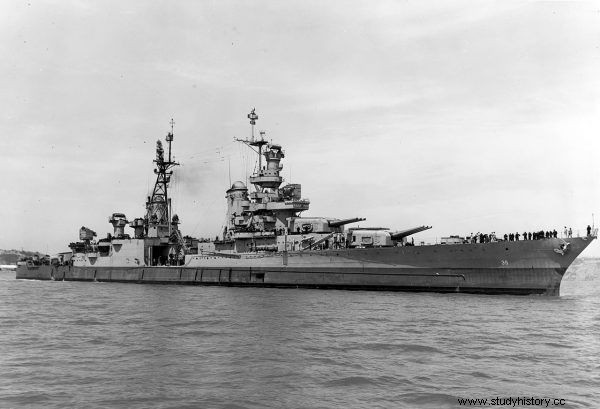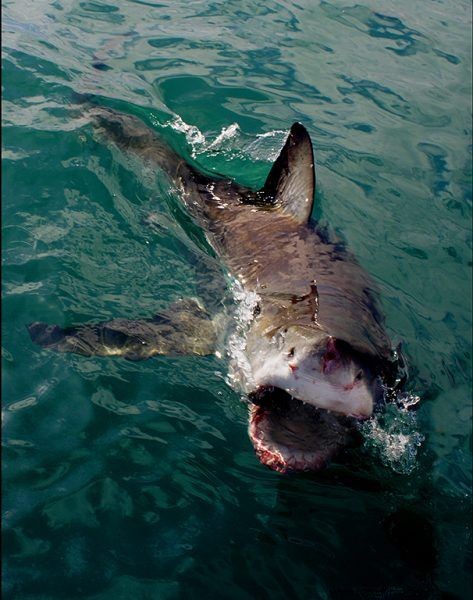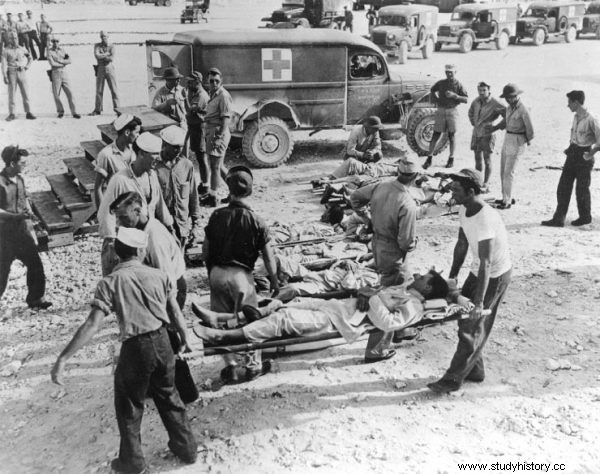Of the nearly 1,200-strong crew of the USS Indianapolis, only 316 survived. Not all who died drowned. Some died of exhaustion, thirst or ... torn to pieces by hungry sharks.
Nothing foreshadowed a catastrophe. On July 30, 1945, the USS Indianapolis cruiser was returning from its top-secret mission - on board it transported the key elements of the Little Boy atomic bomb, which was about to fall on Hiroshima, deciding the outcome of World War II. However, this is not why the ship, which President Franklin Delano Roosevelt was particularly fond of (he made his first official foreign visit in 1936), went down in history. Sławomir Brzeziński reports:
The sea was calm and the cruiser was making the obligatory zigzags (according to another version, the zigzags stopped at nightfall), with only four cauldrons under steam. It can be seen that the possibility of an enemy attack was rather not taken seriously. Meanwhile, at 0:14 on July 30, two torpedoes struck the starboard side of the ship.
It was merely a prelude to the drama that would unfold in the waters of the Pacific over the next five days.
Hit, sunk!
The grim irony of fate is that it was a coincidence that the sunk of Roosevelt's favorite ship was a matter of chance. A series of unfortunate events left the USS Indianapolis far from land, without escort or sonar, and its path crossed the path of the "stray" I-58 led by Machitsura Hashimoto.

USS Indianapolis was returning from its top secret mission - key elements of the Little Boy nuclear bomb were transported on board it
During the night of July 29-30, the Japanese submarine surfaced - almost next to the American cruiser gliding in the darkness. Hashimoto, convinced that he had hit an Idaho-class battleship, ordered the attack. The Japanese sent six conventional torpedoes at the enemy. A few minutes later, explosions lit the sky. Andrzej Makowski comments:
Nobody knows exactly where Lieutenant Commander Hashimoto's torpedoes landed. It is only known that each of them introduced over four hundred kilograms of explosives into the interior of the USS Indianapolis. The luck of the misfortune was that the torpedo hit the bow part of the ship bypassed the aviation gasoline tanker. If a lethal charge had reached this tank, the cruiser would have burst open immediately. Even the twelve minutes that had saved several hundred crew members would not exist.
But could the survivors really speak of happiness? Those who jumped overboard did not realize that their fate was much worse than a quick death on board ...
Hell on the Big Water
25% of the crew (approx. 300 people) were killed directly as a result of the attack . What about the rest? The sailors did not have much time to evacuate - the ship went to the bottom in just 12 minutes from the first hit. Once in the water, they huddled together in which they drifted together. At first, they believed that help would come soon. Officers convinced them of this, claiming that an SOS signal had been sent before sinking (to this day it is not known whether it was actually sent, but certainly no signal got anywhere, because the on-board explosions destroyed all communication systems).
Many of the crew were already injured then - burned by the blasts or poisoned by the oil floating on the surface of the water. The latter was particularly dangerous. As Andrzej Makowski describes:
Only three of the four groups of survivors had life rafts at their disposal . This was what happened relatively the best. They spent the shortest time in oil-covered water (...). The pus sharply attacked the mucous membranes, reached the stomach, irritated the nasal passages and the larynx, felt nauseous in the mouth and esophagus, and blinded the eyes with inflamed eyes. The unfortunate ones, who did not find salutary rafts, were choked with incessant coughing, weakened in paroxysms of vomiting, beaten and tossed by the waves.

Only 316 crew members survived the catastrophe.
However, as it would soon turn out, the oil bath was not the worst thing for the USS Indianapolis seamen. The prolonged waiting for help from the hour to the hour became more and more difficult also due to the weather. One of the survivors, artilleryman Woody Eugene James, recalled:
A day passed and the night came. It got cold, really cold. In the morning the sun came up and it warmed us up, but it quickly got very hot. Then we prayed that night would come again (...). Some argued that the ship did not sink. That it is just below the surface. They said they had just been there, drank water and ate ice cream. Some got persuaded and dived or left, never to come back again .
Hallucinations caused by excruciating thirst caused some men - against training and common sense - to start drinking salt water.
As a result, their condition only worsened and they were dying in agony. But that wasn't the only threat awaiting the survivors…
Ocean of blood
On the evening of the second day after the sinking of the USS Indianapolis, the seafarers' situation became even more dramatic. The scenes that began to unfold then were nothing short of taken out of the horror film. For it turned out that the ship unluckily sank at the shark feeding site ... "There were hundreds of them. It was quiet and calm and then suddenly someone was screaming terribly. The shark got it, ”said Woody Eugene James. The waters of the Pacific turned red again and again. And help still wasn't coming.
After four days of inertly drifting hundreds of kilometers from the nearest land, most of the survivors were already dead. Only 316 exhausted people were floating on the water. That was when the relief came - as accidental as the attack itself.
During a routine patrol flight, Lieutenant Wilbur C. Gwinn of the VPB-152 reconnaissance squadron spotted an oil stain in the ocean, with hundreds of sailors on the verge of exhaustion. Initially, however, they did not want to believe his revelations about the sunken ship (for reasons unknown to this day, somehow no one noticed that the USS Indianapolis did not reach the port in the Philippines as planned). Finally, after a few hours, the Catalina seaplane was sent, which could take on board ... 9 survivors. It took another couple of hours for the rescue ships to arrive.

USS Indianapolis Sailors Rescued on Guam Island
In the end, 316 crew members (including the captain) survived the cruiser crash. For errors in carrying out the evacuation and failure to zigzag the commander of the USS Indianapolis, Charles Butler McVay, stood before a military court and was even convicted, but later pardoned (although the case had an impact on his psyche - he was tormented by remorse - he committed suicide in 1968) . Decades later, the infamous end of the ship became an inspiration for pop culture. It was featured in the iconic Jaws of the Shark Hunter Quint, and in 2016 the production of USS Indianapolis's Last Mission, starring Nicolas Cage as McVay, hit theaters. Interest in the seamen's tragedy was also briefly revived in 2017, when the wreckage of the cruiser was found.
The USS Indianapolis case has aroused much controversy - but mainly among US Navy command and the victims' families. In fact, three days after the delayed rescue operation, the world forgot about the horror of the survivors. Everyone's eyes turned to Hiroshima, on August 6, the B-29 "Enola Gay" bomber dropped the first atomic bomb in history.
